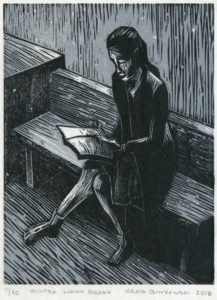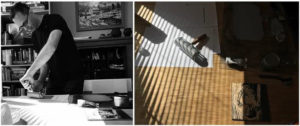Kraig Binkowski has been making prints for almost 30 years since he pulled his first proof off an ancient Charles Brand etching press in college. Throughout his years of printmaking, Kraig has created imagery that explores the play of light across figures and surfaces. Always concerned with process and the inherent and distinctive qualities of mark-making in etchings and woodcuts, Kraig celebrates the richness of the medium – his woodcuts are recognizably “of wood” and never hide the distinctive beauty of carving into wood.
Kraig draws influences from many sources but some of the artists that have strongly affected his work include: Martin Lewis’s tranquil scenes of American city life; the energetic etched lines of John Sloan; Edward Hopper’s solitude; the elemental and passionate mark making of the German Expressionist woodcut artists; Käthe Kollwitz’s sadness; the stillness of Hasui Kawase’s gently falling snow; the wood grain in Helen Frankenthaler’s woodcuts; and the deep shadows in Clare Leighton’s wood engravings.
Some of the universal ideas that weave through all of Kraig’s works are isolation in the urban environment, sadness and tranquillity, nature’s interaction with modern life. In all his prints, Kraig is interested in an honesty of mark making—emphasizing the natural qualities of the wood block and the expressiveness inherent in using woodcut tools to carve images into it. The image and the wood and tools used to create it live harmoniously in each wood cut.
 A recent print of Kraig’s, Winter Lunch Break, portrays a solitary figure sitting outside on a city street, a light snow is falling and is just covering the ground and bench. The woman is unperturbed by the cold and snow and reads her book, alone, on her lunch break. The hard surfaces of the ground and bench are emphasized by strong black lines and softened by the grey tones of a second wood block, with its delicate and irregular wood pattern. Only the pages of the open book, small highlights on the woman and the falling snow flakes are pure white, contrasting with the dark blacks of the woman’s coat and the deep shadows under the bench, contributing to the atmosphere of a dark, grey day.
A recent print of Kraig’s, Winter Lunch Break, portrays a solitary figure sitting outside on a city street, a light snow is falling and is just covering the ground and bench. The woman is unperturbed by the cold and snow and reads her book, alone, on her lunch break. The hard surfaces of the ground and bench are emphasized by strong black lines and softened by the grey tones of a second wood block, with its delicate and irregular wood pattern. Only the pages of the open book, small highlights on the woman and the falling snow flakes are pure white, contrasting with the dark blacks of the woman’s coat and the deep shadows under the bench, contributing to the atmosphere of a dark, grey day.
Kraig’s marks in wood are nothing if not beautiful. Their crisp blackness are repeated with variety and expressiveness, the grain of the wood always an important partner in the prints. His imagery is always contemplative – they are still, quiet scenes though very human. A greyness pervades, but hopeful notes of light and shadow penetrate the solitude.
